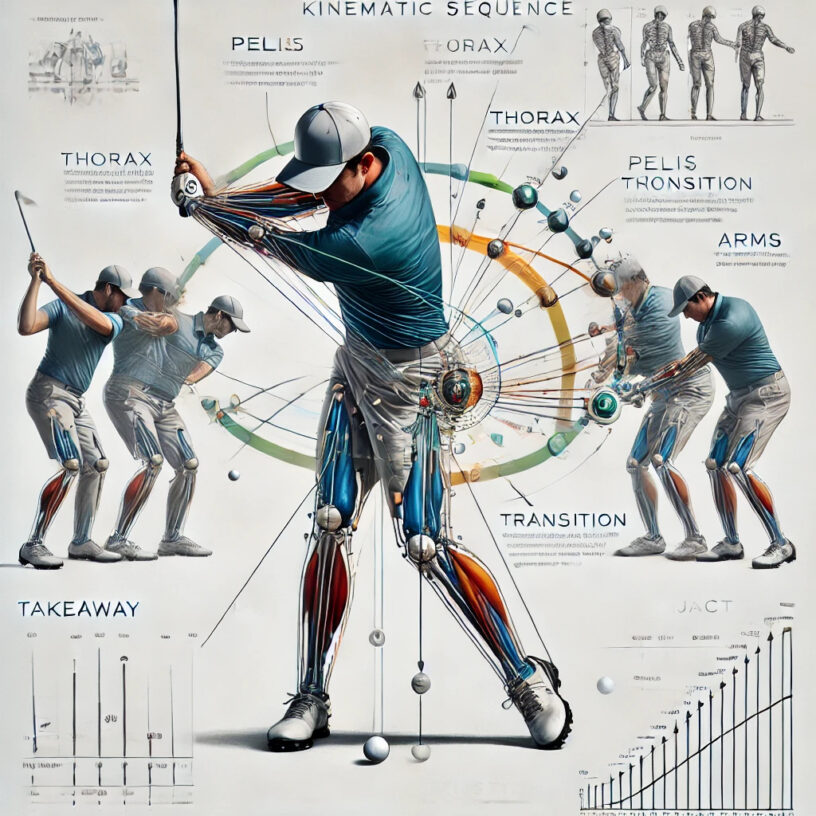In the modern era of golf performance training, few concepts have had as significant an impact as the kinematic sequence. Pioneered in its application to golf by Dr. Greg Rose and the team at the Titleist Performance Institute (TPI), the kinematic sequence refers to the coordinated timing and rotational speed of body segments during the golf swing. This concept has transformed how players train, how coaches analyze swings, and how injuries are prevented. Understanding and optimizing the kinematic sequence is crucial not just for maximizing power and efficiency but also for preserving the long-term health of a golfer.
What is the Kinematic Sequence?
The kinematic sequence describes the order and speed in which different segments of the body rotate during the swing—typically broken down into the pelvis, thorax (torso), arms, and club. An efficient swing follows a very specific and repeatable pattern: the lower body (pelvis) initiates the downswing, followed by the thorax, then the lead arm, and finally the club. Each segment accelerates, reaches peak velocity, and then decelerates to transfer energy to the next segment in line.
According to Dr. Greg Rose, “All great ball strikers follow the same sequence of generating speed and transferring it through the body to the clubhead.” This pattern is consistent among elite-level players and can be reliably measured using 3D motion capture technology.
Why the Kinematic Sequence Matters
1. Maximized Power and Efficiency
When the kinematic sequence is executed properly, each body segment builds upon the speed generated by the previous segment. This cascading transfer of energy, often compared to a whip or a cracking bullwhip, allows golfers to generate maximum clubhead speed without requiring maximum muscular effort.
Dr. Rose notes that “Power in the golf swing comes from proper sequencing—not necessarily from size or strength alone.” That is why players of varying body types—from Rory McIlroy to Justin Thomas—can generate remarkable speed despite differences in stature.
Without proper sequencing, golfers often try to “muscle” the swing, resulting in inefficient movement and decreased energy transfer. This not only reduces clubhead speed but also increases the risk of mechanical flaws and injury.
2. Consistency and Repeatability
A repeatable golf swing is the holy grail of performance. According to TPI, golfers with a consistent kinematic sequence tend to have more reliable ball striking. This is because when the body moves in the same order and timing, it creates a predictable club path and face orientation at impact.
By contrast, an inconsistent sequence—such as starting the downswing with the upper body or arms—can cause compensations that make the swing difficult to control. For example, initiating with the shoulders rather than the hips may lead to an over-the-top move and a steep, glancing blow on the ball.
3. Injury Prevention
Improper sequencing doesn’t just affect performance—it can also lead to injury. Dr. Rose and the TPI team have studied thousands of golfers and found that poor sequencing often correlates with common injuries, particularly in the lower back, lead shoulder, and wrist.
When a segment does not decelerate properly, the next segment is forced to generate power on its own, often resulting in excessive torque and strain. For example, if the pelvis does not decelerate effectively, the torso may attempt to overcompensate, leading to overuse of the spine and surrounding musculature.
TPI emphasizes that “The body must stop rotating in one segment before it can pass that energy to the next segment efficiently.” This deceleration phase is essential for safe and effective power transfer.
4. Objective Data for Coaching and Training
One of the most valuable aspects of analyzing the kinematic sequence is that it provides objective, measurable data. Using 3D motion capture, coaches can view a golfer’s sequence as a graph showing rotational velocities of each segment over time. These graphs—often referred to as kinematic sequence graphs—allow for precise diagnosis of timing flaws that may not be visible to the naked eye.
Dr. Rose has emphasized that “You cannot always see kinematic flaws in 2D video. The swing might look good, but the data might show an inefficient sequence.” This is particularly important when working with skilled golfers whose mechanics appear sound but who are struggling with power output or pain.
How Golfers Can Improve Their Kinematic Sequence
Improving the kinematic sequence typically requires a combination of technical instruction, physical training, and motor control development. TPI-certified professionals often use movement screenings to identify mobility or stability restrictions that may be affecting sequencing.
Here are some of the most common areas to address:
• Pelvic mobility and core stability: Limited rotation in the hips or weak trunk control can inhibit the proper initiation of the downswing.
• Thoracic spine mobility: The ability to separate upper and lower body rotation—often referred to as “X-factor stretch”—is critical for sequencing.
• Motor pattern training: Drills that teach golfers to initiate from the ground up, such as step drills or medicine ball throws, can engrain proper sequencing.
• Biofeedback tools: Devices like K-Vest or HackMotion provide real-time feedback on segment rotation and sequence timing.
Dr. Rose explains, “You have to train the body to move correctly before you can teach it to swing correctly.” Without addressing underlying movement dysfunctions, swing flaws are likely to persist.
The widespread adoption of the kinematic sequence model has fundamentally changed how golf is taught and trained. Elite instructors no longer rely solely on swing aesthetics or subjective feel. Instead, they utilize data-driven tools and a biomechanical understanding of how power is generated.
TPI’s philosophy—“There’s no one way to swing, but there is one efficient way for every player to swing”—underscores the value of understanding each golfer’s physical capabilities and how those capabilities influence their sequence.
As more recreational golfers gain access to technology and TPI-certified instruction, the gap between professional and amateur-level training continues to close. Whether you’re a weekend golfer or a competitive player, mastering your kinematic sequence is one of the most effective ways to elevate your game.

